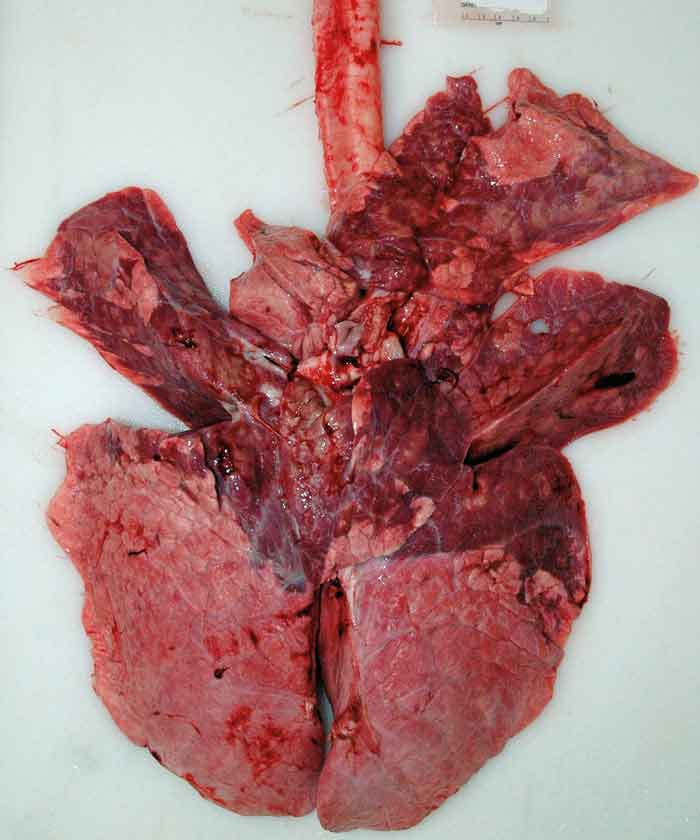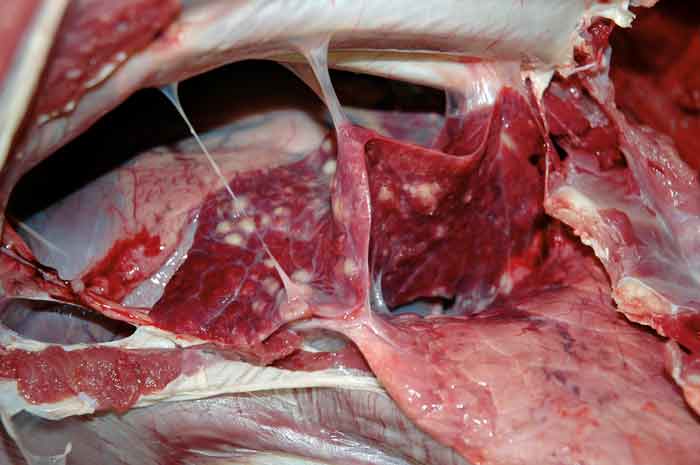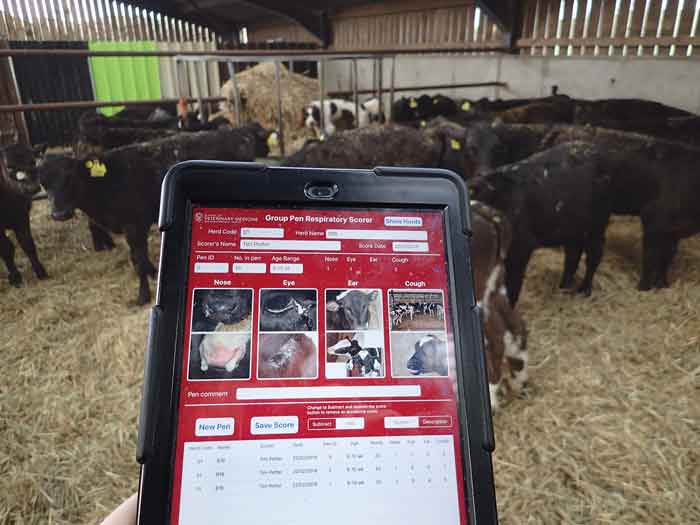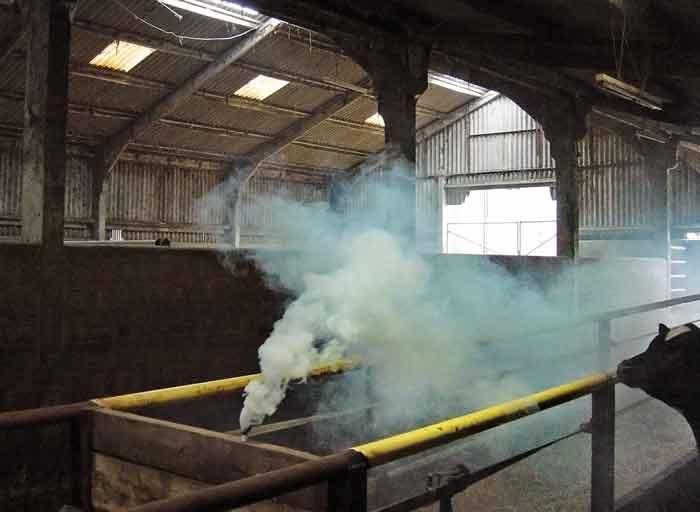3 Apr 2019
Tim Potter looks how vets can help clients manage at one of the leading causes of losses in the beef and dairy industry.

Figure 3. Scoring tools can be used to rapidly assess respiratory health at a group level.
Responsible use of antimicrobials remains very much on the agenda, with a number of ongoing initiatives and campaigns, and it is important this is part of the discussion when considering the management of any disease on farm.
Bovine respiratory disease (BRD) was one of six conditions highlighted by RUMA’s Targets Task Force Report1 as a main reason for antimicrobial usage in beef cattle.
The report also set out a plan to monitor the use of respiratory vaccinations across the sector and aims for a year-on-year increase between 2017 and 2020.
Figures published in 20182 show an increased uptake of pneumonia vaccination has taken place, with the percentage of cattle aged younger than one year old being vaccinated rising to an estimated 38% in 2017 (estimated at 29% in 2011). However, the report also highlights a large proportion of animals are not receiving any pneumonia vaccines, so the opportunity exists for further engagement.
BRD is a multifactorial syndrome and it is beyond the scope of this article to provide an in-depth review of all the potential causative organisms. Instead, it will focus on the identification and management of the disease.
The traditional method for disease detection on farm is for farm staff to evaluate the health of their stock subjectively, based on behaviour and appearance. This, unfortunately, has limited sensitivity (62%) for detecting BRD3, due, in part, to cattle’s natural tendency as prey animals to mask signs of disease and weakness4.
Detection is further hampered by the clinical signs being observed (for example, depression, loss of appetite, respiratory character change and increased rectal temperature) not being specific for BRD5. This can lead to cattle with BRD often being detected late in the disease process or not detected at all6.
This observation is supported by abattoir studies that identified moderate to severe lung lesions in 35% of animals, of which 64% had no recorded treatments for BRD7.
It is well known effective treatment and control of respiratory disease is determined by rapid and accurate identification of disease, and increase in specificity of BRD diagnosis would lead to more prudent use of antimicrobials and lower costs of BRD control8. So how do we go about improving disease detection at a farm level?
One of the key roles of vets is the provision of education to enable rapid and accurate disease identification. Regular reviews of performance records (daily liveweight gains, medicine records and mortality data) can facilitate discussions and highlight areas that require targeting.
It is also important we challenge perceived normality; is it acceptable a background cough is always present? Is the number of treatments higher than would be expected? Benchmarking and providing targets are a key step in motivating change on farm.
Medicine reviews, which are now required as part of the Red Tractor Standards, provide an ideal opportunity to engage with farmers on this topic, as I hazard a guess BRD will be the main reason for usage of antibiotics on the majority of beef farms.
At a farm level, the costs of BRD to both dairy and beef producers are well known, with figures of £43 per dairy calf and £82 per suckler calf being frequently quoted9. However, people often struggle to relate to these values.
Using actual farm data is often more effective in getting people to understand the cost benefit in investing in building alterations or vaccination programmes; even if it is as simple as looking at what they have spent on treatments in the past 12 months and the number of losses.


To allow more objective characterisation of BRD, a number of clinical scoring systems have been proposed for respiratory disease diagnosis in calves, including the Wisconsin system10, which uses five clinical signs, each partitioned into four levels of severity to assign a composite score that a decision to treat can be made on.
The inclusion of rectal temperature in the scoring system necessitates handling of animals to get the full score, although an alternative group scoring methodology, which does not include rectal temperature, is available from the University of Wisconsin as an app. This tool is extremely useful for providing objective data on the respiratory health of large groups over multiple pens.
Other scoring systems are also in use, such as the one described by Love et al11. The so-called California system relies on a simpler design and the presence or absence of clinical signs, and it uses model-based scores, meaning only calves with either nasal discharge – or any two clinical signs of spontaneous cough, ocular discharge, or abnormal respiration – would require calf handling to measure rectal temperature and confirm BRD status.
Whichever system is chosen, the aim is for it to be applied regularly as a screening tool to identify pre-weaned calves with respiratory disease, thereby facilitating early detection.
On farms where such screening is not being regularly carried out, the performance of a one-off assessment can provide a useful snapshot of what is going on the unit and, when considered in combination with the latest treatment records, can prove a useful discussion point on disease recognition with the farmer.
If you are dealing with farms that are finishing cattle, do not underestimate the value of abattoir data. Lung scoring can provide an objective indicator of the amount of respiratory disease in finished cattle, and the data can be used in combination with slaughter weights and carcase grades to demonstrate the impact of the disease.
Various scoring systems are available that use a combination of visual inspection and palpation to detect any tissue consolidation. In one system, the left and right cranial, cardiac and diaphragmatic lobes are scored individually as follows:
The scores are then added together and the lungs are classified by total lung score:
The aforementioned scoring system can also be used as part of any postmortem examination, to provide objective information on respiratory health. The author finds postmortems a great way of facilitating discussions with farmers about respiratory disease, with a severely fibrosed set of lungs being an unarguable way of demonstrating why late interventions are going to be ineffective.

In the live animal, ultrasonography can be used to assess lung pathology, and identify areas of consolidation and pleural irregularities12. The animals do not require clipping; application of surgical spirit to the thorax and the linear probe, used for rectal examinations, will be sufficient to get diagnostic-quality images.
While the time taken to perform the examination, and the experience required for interpretation, may make ultrasound inappropriate for the routine screening of large cohorts of animals, to evaluate future performance it can definitely be a useful tool for providing prognostic information in individual cases.
With the issue with detection widely acknowledged, we are increasingly seeing technology being implemented as a means of aiding disease detection on farms; accelerometers, pedometers, appetite monitors, feed consumption detection systems, remote temperature recording devices, radiant heat detectors and electronic stethoscopes are all being looked at.
With hyperthermia providing the first evidence of BRD in cattle, particular interest has been shown in automated temperature measuring devices (for example, reticuloruminal blouses and eartags measuring tympanic temperature). These can only serve as an alert for a potentially diseased animal, however, and further clinical evaluation of suspect animals is necessary because changes in body temperature are not only caused by BRD.
Having correctly diagnosed BRD, what are the next steps? Antimicrobials are the main component of most treatment regimes and a wide selection of products is at the vet’s disposal. The exact choice of antimicrobial is dependent on a number of factors, including the vet’s previous experience on the farm and elsewhere, and reported susceptibility patterns.
We could get into lengthy discussions on the pharmacokinetics of the different licensed products, and how rapidly following administration they reach maximal concentration at the site of action. All too often, though, the determinant of treatment success rate is not going to be down to drug absorption and distribution, instead being directly linked to how rapidly treatment was initiated.
NSAIDs are often employed alongside antimicrobials in the management of BRD to decrease the severity of clinical symptoms, increase appetite and decrease the lung damage associated with inflammation. The use of NSAIDs as an ancillary treatment to BRD results in a more rapid decrease in rectal temperature, and data suggests NSAIDs may decrease lung lesions at slaughter16.
As we strive to reduce antimicrobial usage on farm, interest has been increasing about the potential role for NSAID treatment alone very early in the BRD disease process. Studies have demonstrated this can be effective in 25.7% of cases17, although further work is required to understand the long-term impact of this type of intervention.
It is important that, once an outbreak is under control, changes are made, where appropriate, to reduce the likelihood of future outbreaks. A thorough assessment of the environment is required, ensuring it appropriately meets all the basic requirements for the livestock:

We are privileged to have a wide range of efficacious vaccines licensed and available for the management of BRD in the UK. However, for them to work effectively we must ensure a number of factors:
Incidence rates for BRD have remained essentially unchanged in the past 20 years, despite the availability and use of many bovine respiratory pathogen vaccines and new antimicrobial drugs, as well as greater understanding of the disease’s pathogenesis19.
The lack of progress in controlling respiratory disease demonstrates the continuing need for significant room for improvement in controlling this multifactorial syndrome, and the vet has a key role in driving this forward.